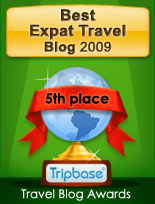During the week, people who worked there were making decisions about a portfolio of companies collected into Borusan Holding Company. On weekends, from 10 a.m. - 8 p.m. the whole building gets opened up to the public to explore and enjoy.
The entrance to the haunted mansion
did not feature cobwebs.
Instead, it hinted at the art collection focus:
many contemporary,
and especially,
video installations.
This particular piece of art
created by a German artist
used solar energy to power propellers
and
and
musical instruments
that emitted pleasing tones
This temporary exhibit was entitled Datascapes.
On the surface,
these may look like black and white photographs
of extraordinary mountain vistas.
What you see, is not what you get.
Each photo had been manipulated to represent
a set of financial data.
I'll let you guess,
which vista goes with which financial data set:
Nasdaq '80-'09 ,
and HangSeng '80-'09,
and Lehman Brothers '92-'08.
What great fun!
And what a clever way for an investor
to internalize the pattern.
This data visualization fascinated me
as it was the first time I had seen it used
for an art museum application.
A blue dot represented a certain collector.
A black dot represented a certain artist;
and a green dot represented a prediction
for an artist or a collector.
I found it to be a very cool
marketing, pricing, and strategy tool.
Wow!
The breathtaking conference room
near the very top of the building.
Our museum guide shared that it illustrated
one of the focuses of the collection:
color repetition.
It made me wonder if there were any works of art
by Turkish artist Setenay Özbek
in the collection.
in the collection.
Her work would fit right in.
A view to the right
featured the ancient Rumeli Hisari fortress
on the Bosphorus
and closer in,
a minaret complete with an
emblematic crescent
at the top.
From the center end of the conference room,
I think it would be impossible to be bored
waiting for a meeting to start, don't you?
Instead of looking right or center,
let's now look left,
where there are doors
leading out to the terrace.
Don't you want to see the view
of the Bosphorus
from out there?
I do.
Wow! Wow! Wow!
Who doesn't love container ships?
And that glorious mansion or palace!
I wonder what it is.
That's the Black Sea beyond the ship.
The view closer in of the neighborhood.
A constant thought I had
during my visit is how
every aspect of the building
would delight any child
who comes to visit.
Yes, this is seating,
but how would a five-year-old use this?
It doesn't roll.
I checked.
So what's at the very top
of the haunted mansion?
In the very top turret?
Let's go look.
A perfect little spot for
two to four people
to close a deal.
Notice the color repetition
of coffee.
Magnificent.
Come back tomorrow to explore the offices of Borusan Contemporary in my third post on Istanbul's haunted mansion or Perili Köşk. Now you have discovery in your day too!
In case you missed it, here's my first post
on Turkey's first office art museum,
Borusan Contemporary:
Some additional posts about art you might enjoy:
Yes, Empty Nest Expat is on Facebook. Follow my blog there with a "like."








































































 Who links to me?
Who links to me?
